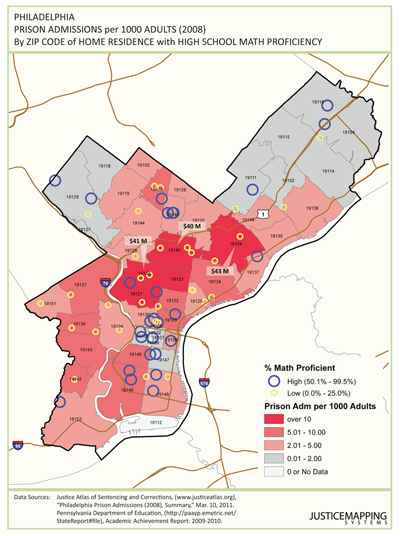Educate, Don’t Incarcerate

On April 7th, the NAACP released a report titled Misplaced Priorities: Over Incarcerate Under Educate. The report "examines America’s escalating levels of prison spending and its impact on state budgets and our nation’s children.” It offers profiles of 6 cities to illustrate the contrast between prison and education spending.
In Philadelphia for example, the NAACP reports that:
“Of the city’s 35 lower performing schools, 23 (66 percent) are clustered in or very near neighborhoods with the highest rates of incarceration — where the biggest taxpayer investment is being made towards incarceration. By contrast, of Philadelphia’s 28 higher performing schools, 21 (75 percent) are in neighborhoods with the lowest rates of incarceration.”
The correlation between quality educational opportunities and potential future incarceration is incontrovertible. A couple of years ago, a report titled The Consequences of Dropping Out of High School determined that:
“During the 2006-2007 time period, 1.4% of the nation’s 16-24 year olds (men and women combined) were institutionalized of whom nearly 93% were residing in correctional facilities (jails, prisons, juvenile detention centers). The share of these young adults who were institutionalized varied widely across educational attainment/schooling groups with high school dropouts being the most likely to be incarcerated. Only 1 in 1,000 bachelor degree holders were institutionalized versus .7% of out-of-school adults who completed 1-3 years of post-secondary schooling, 1.0% of high school graduates, and 6.3% of high school dropouts lacking a GED certificate. The incidence of institutionalization problems among young high school dropouts was more than 63 times higher than among young four year college graduates.”
We know that the very best way to prevent future incarceration is to invest on the front end in providing excellent educational opportunities for children. A 2007 study estimated that the U.S. could save $209,000 in prison and other costs for every potential dropout who could be supported to complete high school. However, for years now, the U.S. has neglected its educational system and instead pursued a racist “tough-on-crime” policy that has resulted in locking up millions of black and brown people.
We have arrived at a historical moment where the massive expansion of the U.S. prison population has become increasingly expensive for states and localities. Between 1987 and 2007, the nation’s prison population tripled, increasing by 1 million people. During the last two decades, state spending on prisons grew by 127%, six times the rate of spending on higher education. Many governors and mayors who recognize the negative fiscal impact of prisons on their state budgets are looking for alternatives.
This is the moment for those of us who have been organizing to close prisons to mobilize the public in our favor. For years, we have made the moral case for prison “reform” or abolition and still the numbers of black and brown bodies behind bars continue to increase unabated. Now that our federal, state, and local governments are implementing fiscal austerity measures, we need to advocate loudly that the supposedly limited available resources be invested in educating our community members as opposed to caging them. The group in our society that most understands this are our youth. They have created youth-led organizations and initiatives such as Books Not Bars and they have also produced short films on this topic. We should heed their calls. This is our time to close prisons and to focus instead on educating our children.
– By Mariame Kaba, Project NIA
